![7 Things That Are Common Sense For Dog Trainers But Not Dog Owners]()
by Liz Wyant | Mar 5, 2015 | Communication
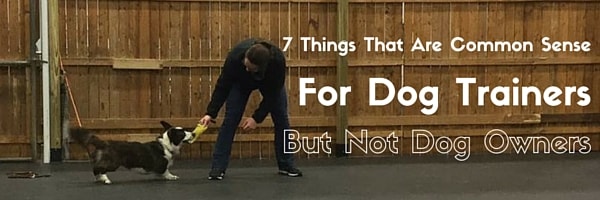
As a modern dog trainer, you have invested a lot of time and energy into becoming the best, most educated trainer you can be. Throughout this journey, many basic ideas were hammered into your head time and again, until they just became basic knowledge. Unfortunately, sometimes these basic things are taken for granted by dog trainers and our clients are left hanging without this information. Here are several things that dog trainers take as common knowledge but clients might not realize.
Click And THEN Treat
When teaching clients that are new to clicker training the basic mechanics, a lot of time is often spent repeating the mantra, “click and THEN treat.” It seems a very natural behavior to click and offer the treat simultaneously. As a modern dog trainer, you will gently remind your clients of the proper sequence of this until it becomes second nature to them, too.
“Have A Ton Of Treats”
When a dog trainer says, “have a ton of treats handy,” they are envisioning a gallon-size ziploc bag of small, soft, stinky treats. When new clients hear this, however, their vision is slightly different. What you often walk into is a client proudly bearing one small ziploc bag of crunchy cookies (see below!). Make sure when you plan your first meeting with a client that you specify what you mean by, “have a ton of treats.” And then take extras of your own. *wink*
High Value Treats =/= Milkbones
Every modern dog trainer has been there – they meet with a client after telling them what kind/amount of treats to have, and the client has big hard biscuit-style treats. As a pre-emptive strike, always specify, “small, soft, stinky, and lots of them!”
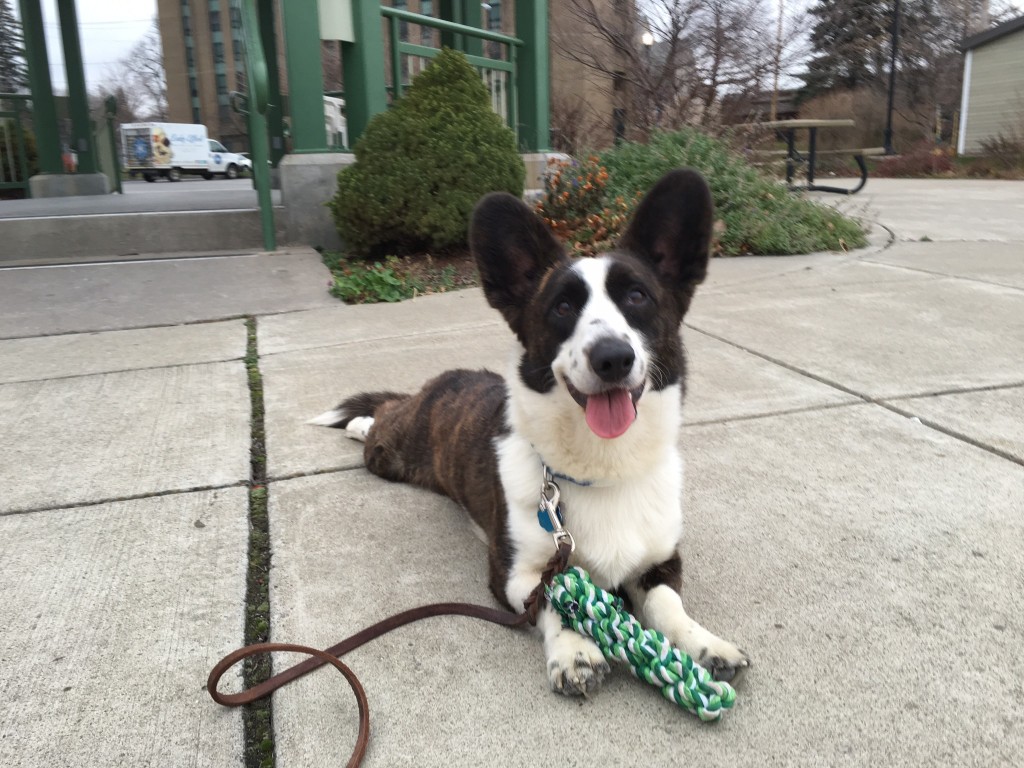
You Have To Work Outside Your Formal Training Sessions
Working on skills learned in formal training with their dog trainer must occur even when the trainer is not present. Five to ten minutes, once or twice a day is all that is needed, but even that can be difficult for some clients. Emphasize that short sessions are okay, and even preferable!
“He Was Hungry”
As a modern dog trainer who understands the power that food can have as a reinforcer, you naturally know that a dog that is slightly hungry will work even harder. However, your clients are unwitting victims of the “hungry dog” eyes and prone to feed their dog a large meal right before training. Remind your clients that they should skip the meal right before training, or at least reduce it in size.
“His Tail Was Wagging, So He Was Happy”
This phrase can make even the most hardened dog trainer cringe. It is vitally important that you help your clients learn basic dog body language, for their safety and their dog’s safety.
Sometimes He DOESN’T “Just Want To Say Hi”
Yet another phrase that can bring a dog trainer crashing to their knees in despair. This can result from a couple different options. First, your client’s dog is truly super friendly and they don’t realize how horrifying it can be to other dog owners to have a loose dog come rushing up to them and their dog. Or second, their dog wants to do much more nefarious things than just say hi, but your client doesn’t understand body language. Explain the importance of keeping dogs on leash when not safely contained, and not permitting their dogs to get in the face of every other dog in the neighborhood.
Training Is Not A Luxury
As a modern dog trainer, you realize the importance that training provides in a dog’s life in the form of mental stimulation, ability to adapt to different situations, and just providing the dog guidelines for living in a human world. Make sure your clients realize that budgeting for dog training is just as important as budgeting for basic veterinary care.
What other concepts do you find yourself taking for granted while your clients are left hanging?
Get Dog Training Business Tips!
Receive valuable dog training business tips and resources every week! Subscribe to The Modern Dog Trainer now by submitting your name and email below.
[mc4wp_form]
![7 Things That Are Common Sense For Dog Trainers But Not Dog Owners]()
by Ashley Oslund Altamirano | Feb 5, 2015 | Business, Communication, Events

Whether you are starting out or are well-established, keeping your business going is not always a walk in the park. There is so much to consider but perhaps the most central concern is that of getting your name out to the general public. There are several ways to do this, each with their own particular pros and cons. Your dog training business’s success will depend on your ability to be recognized. There is no better way to do this than by NETWORKING and ‘oh my gosh’ it can be daunting task. However, once you get past the initial shock of the concept, you’ll find that it’s actually quite easy.
Recommended Reading: Why You Should Do Some Market Research Before Starting Your Dog Training Business
Reaching Out To Fellow Dog Trainers
The way I started networking is what I have termed ‘going in cold’. I directly emailed nearby trainers (to the North, South and West of me) whose philosophies and training styles most resonated with me. I still remember the first email I sent asking to meet up for coffee or lunch. I regretted hitting the send button almost immediately! But my fears were quickly put to rest. I had failed to realize how warm and willing to help out a well-qualified and experienced dog trainer could be. Thank you John, Linda and Pat for replying to my random invite for coffee! That one little reply email was the stepping-stone for me to connect with other trainers and learn the ropes. It was free and best of all has led to the development of awesome friendships and professional contacts. Even more, the relationships I went out on a limb and created allowed me to learn about how I wanted certain aspects of my own business to be. They even led to my first referrals and clients.
Now the ‘going in cold’ networking method isn’t the only way to gain recognition. You can accomplish the same by going through a paid organization, specifically ones like your local Chamber of Commerce or private associations like Business Network International. They both will cost you up front but they do have the potential to drum up solid business leads and turn you into a permanent fixture in your local community.
Related: Check out our “Mastermind Meetups for Modern Dog Trainers” and request one in your area!
Join Your Chamber Of Commerce
The most familiar of the two is the local Chamber of Commerce. They typically work to increase your business’s visibility by listing your company on their exclusive business directory. Basically a digital Rolodex accessible via the chamber’s website to help customers find relevant services. They also publish monthly, quarterly, and or annual newsletters that feature local business and community activities. Typically you pay a fee to advertise in them. This cost is independent of the membership price, which can either be a flat rate (typically $400 plus) or a scaled fee. The scaled rate is dependent on the size or type of business, e.g. professionals and large corporations being charged the highest. Most all Chamber of Commerce advertise that they will increase your business’s exposure and recognition. For the most part they do deliver on that promise as is documented by a 2012 research study conducted by the Schaprio Group. They determined that membership is seen as “an effective business strategy” by 59% of consumers. More important for dog trainers is how the study indicates that people will see your business as one that both employs “good business practices” and is “reputable” within the community.
The benefits of being a member are not just limited to customer’s perception or being listed in a directory. The hidden value extends from the meaningful face-to-face relationships you will create with local professionals. Through sponsored business mixers and social events (business conferences or luncheons) you will get to know the businesses in your area in person. It is at these events you can make contact with service providers that you, as a business owner, might be in need of–like a quality accountant, photographer, or pet friendly real estate agent. Before you take the leap, keep in mind that programs and service are not all the same. So check with your town’s local Chamber of Commerce for specifics at the US Chamber of Commerce Directory.
Become A Member Of BNI
Another well-known organization focused on improving business success by way of networking is Business Network International. BNI is based on the idea that “givers gain” and founded by Dr. Ivan R. Misner in 1985. Each chapter creates a concentrated environment for professionals and local business owners to interact and direct potential customers between them through word-of-mouth marketing. It is quite effective when utilized.
BNI will let you attend a local chapter before joining in order to get a better feel for what they offer. In my case, I attended a meeting that averaged about an hour in length. My sponsor (who invited me) asked that I have ready a 60 second bio about myself, my business, and what goals I have. While a 60 second introduction may feel like a trial by fire, it actually was a great icebreaker as chapter members have had the same experience at one point in their careers. There are some particular rules to be aware of when attending. For instance, each local chapter is limited to only one member of a particular profession/business. This means that there will be only one lawyer, one mechanic, or one dog trainer within the group; however there can be multiple chapters within a city. You can visit a group for FREE twice before deciding whether or not you want to join! Much like the Chamber of Commerce, you will get the chance to gain inside access to professional services that are needed by business owners. In the chapter I belong to I connected with a CPA and a professional photographer that will be a phenomenal help to my business. The carpet cleaning company is also in my sights 😉
In the end the possibilities are boundless when it comes to successful networking. Networking is about getting to know your neighbors and building relationships so you can both succeed. So however you get it done – it will certainly help you out in the long run. Where and how have you had the best experiences networking? Are you a member of any business organizations?
Get Dog Training Business Tips!
Receive valuable dog training business tips and resources every week! Subscribe to The Modern Dog Trainer now by submitting your name and email below.
[mc4wp_form]
![7 Things That Are Common Sense For Dog Trainers But Not Dog Owners]()
by TMDT Team | Jan 13, 2015 | Communication
 Dominance
Dominance
If you work with dog owners or cruise the dog behavior groups on Facebook you will often see dogs that are labeled ‘dominant’. I hear this most often in client homes where they have multiple dogs and have categorized one as the dominant or “alpha” dog because of its interactions with the other dogs.
It is often described as the dog who is stealing all the toys, pushing the others out of the way at the doorways, hoarding all of the chew bones or fighting over them, seeking – if not demanding – the humans’ attention away from the other dogs, guarding the food or water bowls, playing too roughly and ‘enthusiastically’ with the other dogs, or keeping the other dogs off of the comfortable resting areas so they can have them as their own. It appears to be seen even more predominantly within a household where the dogs are of similar age, especially siblings.
 However, if you take the same dogs out of the comfort of their home or familiar territory (such as a well-frequented dog park) or even away from their familiar play mates, you may see a very different dog. One that is much more hesitant around new things, interacts in a shy or reactive way to other dogs and/or people or perhaps they act overly friendly with a lot of jumping around other dogs or people, doing lots of ‘kissing’, lots of soft body curves, mouth licking, submissive grins, lowered head, or even excessive mouthing, all which can become obnoxious submission. So how can it be that this dog that is SO ‘dominant’ in one situation is so different in another?
However, if you take the same dogs out of the comfort of their home or familiar territory (such as a well-frequented dog park) or even away from their familiar play mates, you may see a very different dog. One that is much more hesitant around new things, interacts in a shy or reactive way to other dogs and/or people or perhaps they act overly friendly with a lot of jumping around other dogs or people, doing lots of ‘kissing’, lots of soft body curves, mouth licking, submissive grins, lowered head, or even excessive mouthing, all which can become obnoxious submission. So how can it be that this dog that is SO ‘dominant’ in one situation is so different in another?
Remember the bully on the playground in grade school or the class clown in your high school class? There is a similarity between humans and canines in that insecurity and anxiety will be displayed in a variety of ways. The dog that is pushy and easily over aroused and gets into squabbles with the housemates is much like the bully on the playground, whereas the obnoxiously submissive dog that is constantly seeking approval from the other dogs and/or humans is much like the class clown! You may see both behavior displays from the same dog, just in different situations. The fake ‘dominance display’ is often seen at home and in familiar surroundings whereas the submissive display may be seen in a novel environment or circumstance. The latter is usually not of much concern to most dog owners other than it can be a little annoying, but that obnoxious submission can be extremely irritating to some dogs and can actually cause an escalation in communication efforts that may result in aggression. We have an adult Great Pyrenees, Mama Shay, who is excellent at giving and reading canine body language. She can meet and greet almost any dog that is willing to ‘listen’ to her because she is never forward in her approach unless invited by the other dog through appropriate body language. However, young dogs that fall into the category of obnoxiously submissive, really push her buttons. She will give them an appropriate cut off signal with a head turn or eye avert which usually indicates to a dog with good communication skills that a direct approach is not desired. However, if the dog continues to approach in this overly appeasing way, rolling on the ground showing a submissive grin, doing lots of lip licking and eyes blinking like a flickering Christmas tree bulb, she may be pushed to the level of giving a small growl to warn them away. This in turn, makes them seek approval even more intensely and that can often result in a Great Pyrenees who is irritated and would escalate into more aggressive displays if we did not intervene.
 Once a dog like this become familiar with their environment and the other dogs in the play group they often turn to the bullying behavior so often referred to as dominance. By being bouncy, barky, and mouthy during play, or playing in a way that can be over the top with a lot of acrobatic movements, pushing the other dogs out of the way as they go through the doorway, or hogging the human interaction from the other dogs these dogs have gone from what appears to be one extreme to another.
Once a dog like this become familiar with their environment and the other dogs in the play group they often turn to the bullying behavior so often referred to as dominance. By being bouncy, barky, and mouthy during play, or playing in a way that can be over the top with a lot of acrobatic movements, pushing the other dogs out of the way as they go through the doorway, or hogging the human interaction from the other dogs these dogs have gone from what appears to be one extreme to another.
Modern, educated dog trainers know it is always extremely important to identify the behavior and body language of the dogs without labelling it. But pet owners have most likely already done that! When they describe their dog as alpha or dominant it is important to get the actual physical behavior instead of the label. I give them another more accurate characterization of the behavior: “False Bravado”. A dog like this displays an almost over-the-top amount of courage but in reality it is a false show of bravery. As mentioned previously, this behavior is a symptom insecurity or anxiety. The dog is compensating for their lack of confidence and appropriate communication skills by bullying.
Hearing the term ‘dominance or alpha’ can give a trainer a snapshot of what may really be happening in the household and the use of the “False Bravado” term may help us reframe what the pet owner is seeing into a more accurate term.
About The Author
Karen Deeds, CDBC began her career with canines competing in the obedience show ring after being competitive in the horse show ring. Following an incident with her competition dog in 1990 that resulted in an aggression problem, Karen learned the importance of understanding canine behavior and how to manage and modify it.
In 1992, Karen, while working with a local Humane Society, quickly realized the need to educate clients on canine behavior… Far too many dogs were being destroyed because of behavioral problems. She found with education, positive training, & behavior modification, more dogs successfully adapted to a family environment. Canine Connection was founded in 1994 to train owners to connect with their canine partners.
Karen met Bob Deeds in 1998, when she was asked to help his volunteer search and rescue team with a ‘new’ training technique “Clicker Training”. They were married in 2004.
Karen was involved in the Assistance Dog industry for almost 20 years working for 3 different organizations and clients with their service, seizure response, or hearing dogs.
Attending continuing education seminars helps to maintain a high level of knowledge of canine behavior, body language, and proven science based training and behavior modification techniques. Karen was the Tarrant County Veterinary Medical Association’s 2009 Community Service Award winner for her work in the field of canine aggression. In 2010, Karen received the Community Educator of the Year Award from the Association of Pet Dog Trainers (APDT). In 2013 she passed the rigorous criteria to become a Certified Dog Behavior Counselor (CDBC) through the International Association of Animal Behavior Counselors (IAABC).
Both Karen and Bob are active in Dog Scouts of America as instructors at the Texas Mini Camp, teaching a variety of courses. They also continue to assess dogs for working potential in various disciplines such as SAR, narcotics, arson, bedbug, and service work. Bob and Karen currently perform behavioral evaluations and rehabilitation helping the rescue community better place dogs in adoptive homes. They also present numerous seminars for a wide variety of audiences.
Karen’s current canine partner is Cassidy, a golden retriever she adopted from Golden Retriever Rescue of North Texas in April of 2010. They have received their Rally Novice (RN), Rally Advanced (RA), Rally Excellent (RE), Beginner Novice (BN), Novice (CD), and RAE titles and are currently working to compete in AKC Open competition using all force free training.
Get Dog Training Business Tips!
Receive valuable dog training business tips and resources every week! Subscribe to The Modern Dog Trainer now by submitting your name and email below.
[mc4wp_form]
![7 Things That Are Common Sense For Dog Trainers But Not Dog Owners]()
by Thomas Aaron | Dec 18, 2014 | Communication
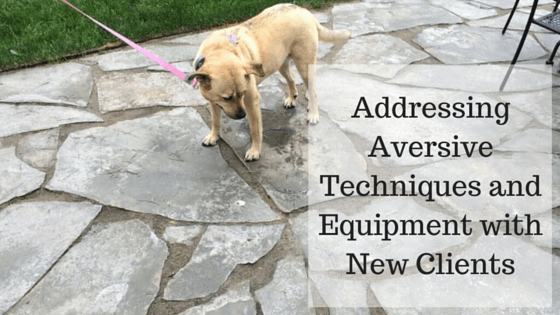
While dog training based on positive reinforcement is quickly gaining mind share, it is not the only game in town. Dog training philosophies range from very aversive, punishment-based paradigms to those that strive to be completely force-free in their approach. And somewhere in the middle of this range, there are trainers who identify themselves as “balanced” to describe their belief that effective dog training requires the use of all four of B.F. Skinner’s learning quadrants (positive reinforcement, negative reinforcement, positive punishment, and negative punishment).
The truth is some of the best behaviorists and behavior analysts of our time have refused to completely disavow punishment in dog training, and most dog trainers who really think it through will acknowledge that not all methods that fall into the positive punishment or negative reinforcement quadrants are inhumane. For example, here is an excellent summary of Dr. Susan Friedman’s “Humane Hierarchy” of dog training. But pretty much all positive reinforcement trainers recognize that methods which empower dogs to make and be rewarded for “correct” decisions tend to be quicker, more effective, longer lasting, and more humane. These methods primarily reside under the umbrella of positive reinforcement.
As positive dog trainers, there are a number of situations where we will find ourselves face to face with people or tools dedicated to aversive methods. For example:
- In shelters and rescues that utilize a variety of trainers from the community. It is not uncommon to find shelters that have adopted aversive methods on the recommendation of available, local aversive trainers.
- In the client’s home when they inform you they have tried aversive equipment or other aversive trainers. And do not be surprised when they tell you some of the trainers or equipment have yielded some degree of success, which they do not want to lose.
- Your client says things that indicate they have bought into the methods of aversive celebrity trainers. On television, such trainers seem to get near-instantaneous results. It only makes sense that a client may have tried to emulate these trainers.
- You might find yourself in a conversation with an aversive trainer. Whether in your community or online, it is difficult to avoid the diversity that exists among dog trainers.
Here is a brief guide about what you should or should not do in these situations.
- Don’t say aversives do not work. It is true that aversives have a failure rate and potential side-effects. Positive trainers have a failure rate as well, often a side-product of a lack of trainer experience or a lack of client follow-through. However, aversives do indeed work, otherwise they would not have been the predominant method of training dogs until the recent growth of positive training mind share. In fact, aversive trainers sport a lot of major titles and accomplishments in nearly every dog sport niche.
- Don’t be critical of the client. The owner would not have called you had they not realized they needed help. They have recognized that what they have been trying is not working, and they are humble enough to ask for YOUR help. Plus, they are indeed your bread and butter.
- Explain the potential side-effects of using aversives. There are many reasons people may be willing to avoid using aversives. For example, aversives might create an unwanted association between the punishment and whatever the dog happens to be looking at; or it could cause complications in the bonding between the owner and the dog.
- Be professional in your discussion of aversive trainers. Nothing turns off a client more than being unprofessional. One aspect of being unprofessional that is difficult to recover from is speaking badly of other trainers. Simply state that you know of the aversive trainer (if you do), that you understand what their perspective was (if you do), and that your take on the problem and how to solve it is a bit different.
- Challenge the client to give your positive approach a try. When the positive approach and its benefits are explained in a clear, educated fashion, most clients are willing to give it a try. Ask the client to bare with you for a few weeks and apply themselves to your method.
- Don’t get in over your head. Some training goals are easier to reach than others. For example, it is easier to teach a dog to sit-stay than it is to cure leash reactivity. If you are not accomplished at working with a particular issue, refer your case to a positive trainer who is — and shadow that trainer if possible. By doing so, the positive approach gets a fair shot, as does the client. And you get to learn something.
We’d love to hear what you have learned about responding to aversive techniques in your own dog training practice in the comments below!
Get Dog Training Business Tips!
Receive valuable dog training business tips and resources every week! Subscribe to The Modern Dog Trainer now by submitting your name and email below.
[mc4wp_form]
![7 Things That Are Common Sense For Dog Trainers But Not Dog Owners]()
by Liz Wyant | Dec 2, 2014 | Communication
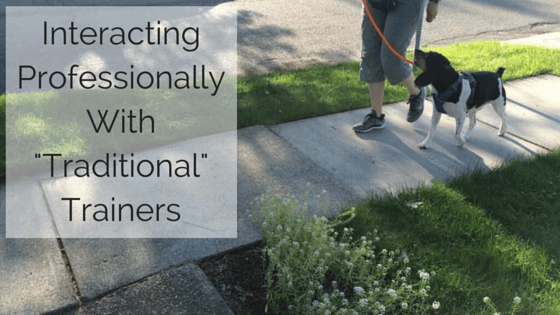
Interacting Professionally Online and In-Person With A Variety Of Dog Trainers
Traditional trainers (those who introduce physical corrections into their training of some sort) are as passionate about their training methods as force-free trainers are about their methods. Unfortunately, this can often cause confrontations when the two types of trainers come together, either in person or via the internet. Arguing is stressful and non-productive, so what are some options for gracefully handling these interactions?
(As an aside, the vast majority of traditional trainers are not interested in arguing and being rude to force-free trainers – this article is to help when dealing with the small minority that revel in being hostile.)
Turn The Other Cheek
Often traditional trainers start slinging around names and insults to rile up force-free trainers. Though it can be frustrating, you should try to ignore this. On the other hand, take the higher ground and do not reciprocate by throwing derogatory terms and names back at them.
Don’t Get Pulled In
Sometimes the easiest option is to walk away. If you know that you are not going to be able to retain your composure whilst discussing your side, give yourself the power to remove yourself. Getting riled up is not going to affect the other person. It will simply make you miserable and possibly reflect badly on your reputation.
Agree To Disagree
Often you just reach a point in conversations where the discussion is going in circles. Your mind is not going to change and neither is their’s. At this point, agree to disagree. Continuing the conversation is going to accomplish nothing other than to annoy you and waste your time. Ending the conversation this way will preserve your sanity and reputation.
Know Your Facts
Before getting involved in discussions, make sure you know your facts. Be prepared to cite books, articles, and other reputable resources that show the power of positive reinforcement. If you are confident about your training methods and why you use them, having the resources to back up your arguments will be helpful.
Above all, remember that positive reinforcement works for people, too. So often, force-free trainers are so passionate about their techniques that they get riled up and lash out when challenged. Arguing will not change minds. Use your personal dogs and the dogs you train as good examples of the power of force-free training. Always keep in mind that everyone is working towards the same goals, you are just pursuing different pathways to get there.
What do you recommend for interactions with traditional trainers who want to argue?
Get Dog Training Business Tips!
Receive valuable dog training business tips and resources every week! Subscribe to The Modern Dog Trainer now by submitting your name and email below.
[mc4wp_form]
![7 Things That Are Common Sense For Dog Trainers But Not Dog Owners]()
by Monica Callahan | Nov 15, 2014 | Communication
Involve The Whole Family In Training
When working with a family and their dog, the children are always excited to help mom and dad train their dog. Parents often push the kids to the side and get frustrated when they keep interrupting. Instead of continually being interrupted, you can incorporate the children in the training. Here are three ways to incorporate your client’s children in training.

1. Recall Games
Children love high energy games, whether they are running or the dogs are. Recall games are a great way to incorporate the client’s children because it can get the dog running and wear them out. Have the children stand across the living room and practice calling the dog’s name once and treat when the dog arrives. They’ll think it’s amazing when the dog listens. Eventually they can play hide and seek and have the dog find them throughout the house. This is also a great bonding game for the dog and children and turns their children into rewards for the dog.
2. Treat Deliverer
This idea would be geared toward the better listener in the family. An example would be working on crate training. If mom or dad has the clicker, just let the child know that whenever they hear a click, they are to give a treat to the dog. When the dog enters the crate and mom or dad click, the child can then deliver a treat to the dog or drop it in the crate.
3. Distraction Training
Children are a big distraction to dogs, and their movements can also be highly alarming to them. You can use their quick movements to proof their dog’s current behaviors or desensitize a worried dog to the child. In the beginning, have the child move slowly and then work up to quicker movements.
Children love to feel like they are being useful. With some simple tweaks to training, children can certainly be incorporated. Once children reach a certain age and maturity, they could even take over training. Training is a great way to bond with their dog, and a pleasant, respectful relationship between children and their dog is important in a family. The next time you have an interruptive child at your training session, don’t allow the parent to get flustered, suggest they help instead.
What are some other ways you, as a trainer, can incorporate children throughout the training process?
Recommended Articles
![7 Things That Are Common Sense For Dog Trainers But Not Dog Owners]()
by Ines | Oct 24, 2014 | Communication, Events
At the APDT Conference last week we had the pleasure of listening to Sumac Grant-Johnson‘s speech called Build A Better Trainer. Sumac is a wonderful dog and people trainer. She engaged the audience like few speakers were able to. Everyone was laughing and enjoying themselves during her speech. Here are some of the highlights of her presentation.

Teaching Skills For Dog Trainers
Many trainers get into dog training for the dogs. However, you have to work with people to make a living so having some people skills are important to being a successful dog trainer.
Sumac has broken down the steps every teacher should take when instructing a class or lesson into an easy-to-remember acronym: OIA. OIA stands for Observe, Interpret, and Act. She encourages all trainers to learn as much about human body language as they do about dog body language. This will increase your ability to understand clients who might be struggling. She stated that if there is a failure rate of more than 25% in a class after instructions are given then the issue lies with the instructions given, not the students.
Observations
As a teacher, you must be able to observe your student’s actions. Look at what they do correctly and incorrectly. See what might be inhibiting them from achieving the goal behavior.
Interpret
Once you’ve made accurate observations, you can then interpret what you’ve observed. Bring into consideration environmental factors such as space, distractions, fears, and noise. She mentioned that you can let clients know what they can do if they cannot hear you appropriately.
Learning Styles
A good instructor understands how to utilize different approaches so that all learning styles are incorporated into their teaching. Learning styles can be broken down into visual, auditory, and kinesthetic. Make sure you’ve researched these styles so that you can identify the learning style of each client.
Knowledge Base
Every client will have a different history and knowledge base. Sumac recommended we read the book
How Doctors Think by Jerome Groopman. You never know right off the bat what kind of training knowledge, behavior knowledge, or experience a client may have. What they know can hold them back in some cases due to prejudices or biases.
One of the most important parts of her presentation was the recommendation to never express differing or conflicting opinions right off the bat or they’ll put up barriers.
Act
After observing and interpreting your client’s behavior, you’ll want to act accordingly. Consider adjusting the environment, avoiding putting people on the spot, and mark and reinforce correct behavior. Sumac recommended the use of words like good, nice, or great as marker words before explaining what they did correctly. Make sure you give your students achievable steps towards the goal behavior just like you would when working with their dogs.
In the end, she states that as dog trainers, we all of ONE job. That is to help people meet THEIR goals. This presentation was one of our favorites out of the whole APDT Conference in Hartford. She is an excellent presenter and intelligent people-person. She claims she used to be extremely shy as a child, but we find that extremely hard to believe! Thank you
Sumac Grant-Johnson for sharing your knowledge with us.
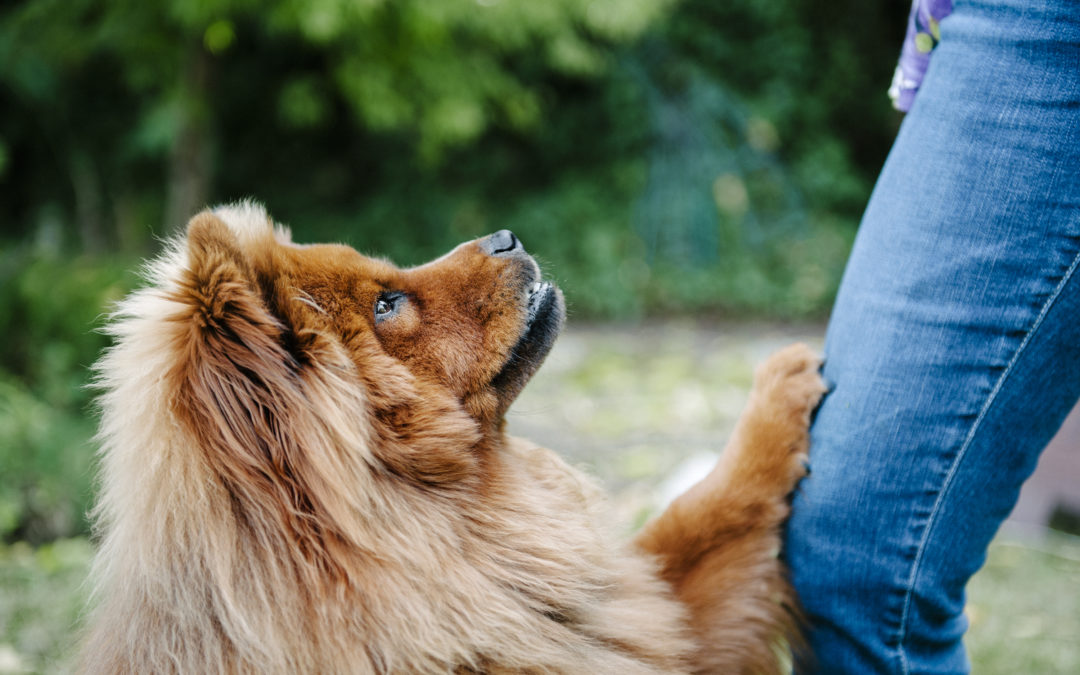
by Ines | Sep 26, 2014 | Business, Communication
Using email newsletters is currently the best way to reach existing and potential clients. Email newsletters let you continue to provide value to your existing clients. They also help you reach out to potential clients who want to know more about you are and what you do. Receiving client’s emails through an email newsletter service, like MailChimp, gives you legal permission to contact them in the future to raise awareness about services you could offer them.
This step-by-step guide to getting your free MailChimp email newsletter account set up will get you started.
Create an Account
Click their red “Sign Up Now” button in the top right corner of the window. Use your business’ email address and a creative password to create your account.

Don’t forget to verify your email before moving forward.
Confirm You Are Human
Once you click the blue “activate account”button in your email, you’ll need to confirm that you are indeed a human by completing the phrase from the reCAPTCHA.

Set Up Your Profile
Next it will take you to the “set up your profile” page. Complete this page as completely as possible. Make sure to put in your real name, website address, and a physical mailing address (legally required).
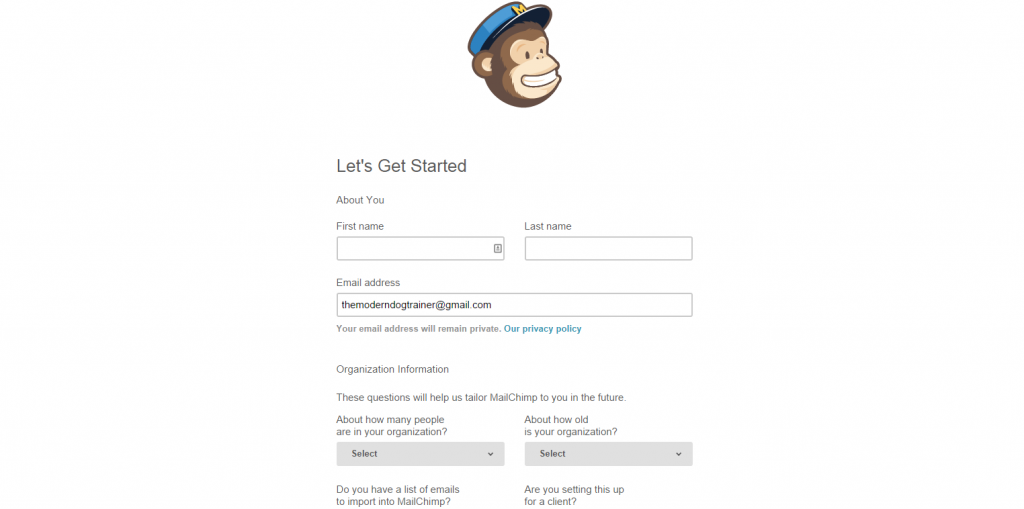
Set Up a Email List
Next you’ll want to create a sign up form so that people can submit their emails to sign up on your website. Select “Create a List” in the botton row.
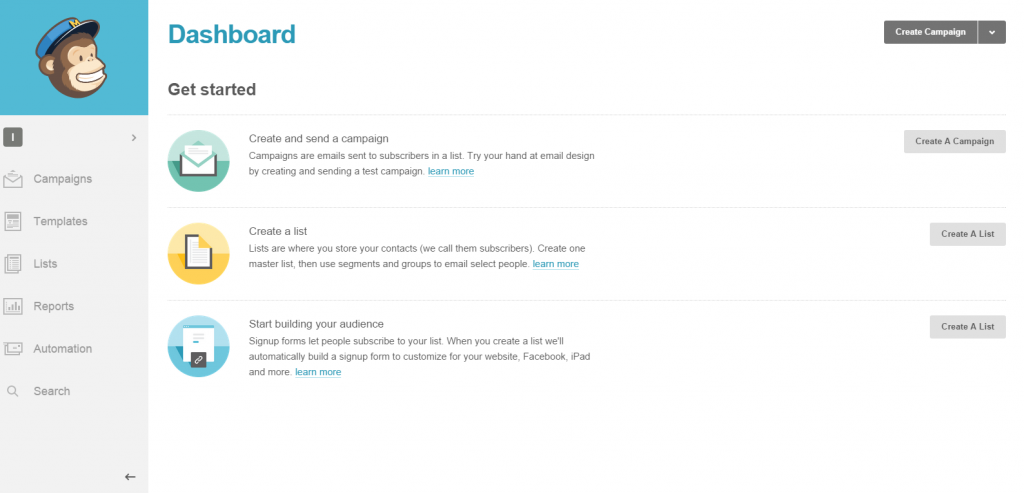 Give your list a name (like “The Modern Dog Trainer Main List”), a default “from email,” and a default “from name” that people will recognize.
Give your list a name (like “The Modern Dog Trainer Main List”), a default “from email,” and a default “from name” that people will recognize.
Once your list is created, select the “create a sign up form” option:
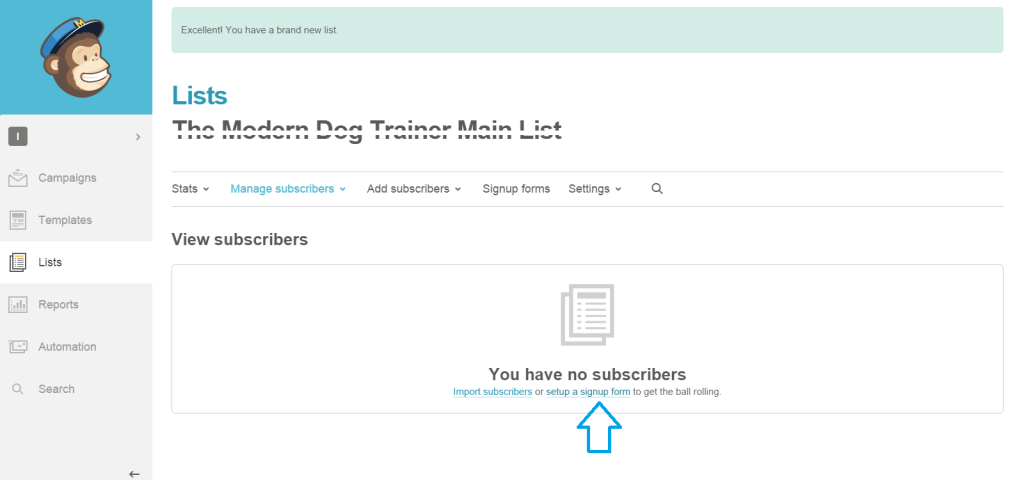
Select the “Embedded Forms” option to create a form you can put on any website.
Creating Your Sign Up Form
Set your sign up form title. Something like “Subscribe to Our Newsletter!” works just fine. Experienced email marketers usually offer a free PDF ebook with simple and fun information in exchange for an email address, but this isn’t always necessary.
Here we recommend only asking for the basic necessities like your reader’s first and last name and email address. The easier it is for them to sign up, the more likely they will be to register. Some sites only ask for email addresses, but it may be to your advantage to recognize clients as they sign up for services.
Set the form width to something between 200 and 300 pixels. Then copy and paste the form onto your website’s sidebar.
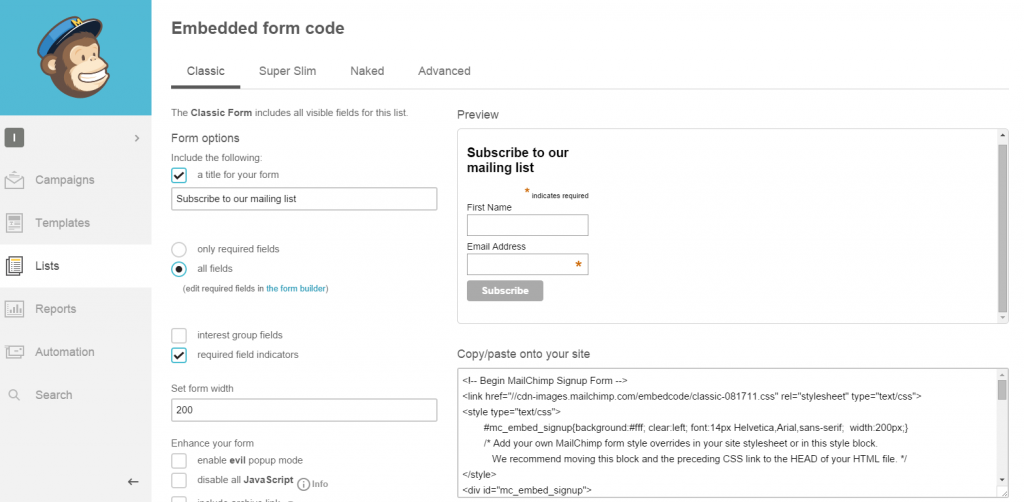
Content For Your Newsletter
Once people sign up through the form, people will be expecting contact from you pretty quickly. If you wait too long before sending the first email, they may forget they even signed up for your newsletter in the first place. Make sure that your first contact with your new follower includes information that they will find useful and valuable. For example, you can think about what the most behavior issues you encounter are and provide quick and easy tips to help with management and prevention.
We hope you’ve enjoyed this tutorial about how to set up an email newsletter using MailChimp! Don’t forget to share this valuable information with your friends.
Recommended Articles




 Dominance
Dominance














